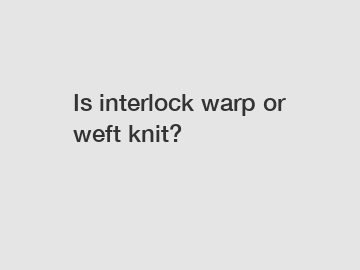Jan. 13, 2024
Textiles & Leather Products
For knitting enthusiasts and textile aficionados, understanding the different techniques used in the creation of fabrics is nothing short of fascinating. One ongoing debate that has piqued the curiosity of many is whether interlock is considered a warp or weft knit. In this blog post, we will delve into the intricacies of interlock knitting, shed light on its construction, and finally reveal whether it belongs to the warp or weft knit family.
Understanding the Basics: Warp Knitting vs. Weft Knitting.
Before diving into the details of interlock knitting, let's first explore the fundamentals of warp and weft knitting. Both techniques are widely used in the textile industry, producing distinct fabric structures.

Warp knitting primarily involves a set of parallel yarns known as warp threads. These threads move vertically during the knitting process, creating loops that interlock with one another to form the fabric. Common examples of warp knitting include tricot and raschel fabrics.
On the other hand, weft knitting, also referred to as circular knitting, uses a single thread, typically referred to as the weft or filling yarn. The weft thread moves horizontally, forming loops that intertwine with one another to construct the fabric. Common examples of weft knitting include jersey, rib, and interlock fabrics.
Understanding Interlock Knitting.
Interlock knitting is a type of weft knitting, meaning it falls under the category of fabrics constructed using a single thread in the horizontal direction. However, unlike other weft-knit fabrics, interlock requires two sets of needles – one needle bed positioned on each side of the fabric.
Interlock knitting produces a double-layered fabric, with the front and back sides identical to each other. The interlock structure features a vertical ribbing effect, making it highly stretchable without losing its shape. This elastic and stable attribute of interlock fabric makes it ideal for various applications, including sportswear, activewear, and baby garments.
The Mystery Unraveled: Interlock is a Weft Knit.
After closely examining the construction and properties of interlock knitting, it is safe to establish that interlock belongs to the weft knit family. Despite its unique construction with two needle beds, interlock still functions similarly to other weft-knit fabrics.
Unlike warp knitting, where the yarns interlock in a vertical direction, interlock creates loops in a horizontal manner, forming a weft-knit structure. Each needle on both beds alternates with the other, allowing for intricate designs and producing a fabric that is virtually the same on both sides.
Interlock fabric showcases the versatility and elasticity characteristic of weft knitting, providing comfort, stretch, and resilience. Although its unique construction might have initially caused confusion, it is clear that interlock is fundamentally a weft-knit fabric.
Conclusion.
The debate surrounding whether interlock is a warp or weft knit has been resolved – interlock is undoubtedly a weft knit. Despite its distinct construction with two needle beds, the interlocking yarn loops still form horizontally, just like other weft-knit fabrics.
Understanding the intricacies and subtleties of different knitting techniques helps us appreciate the breath of textile possibilities available to us. Interlock is a remarkable fabric, offering a range of benefits, including stretchability, stability, and versatility, which have made it a popular choice in several industries.
So, the next time you come across interlock fabric, appreciate its unique double layering and its ability to provide comfort and style in one. As the weaving and knitting world continues to evolve, let us embrace each technique's uniqueness and celebrate the remarkable fabrics they create.
If you want to learn more, please visit our website fireproof fabric kitchen, fluorescent fabric manufacturers, Where To Buy Fire Retardant Fabric.
Previous: Is interlock warp or weft knit?
If you are interested in sending in a Guest Blogger Submission,welcome to write for us!
All Comments ( 0 )